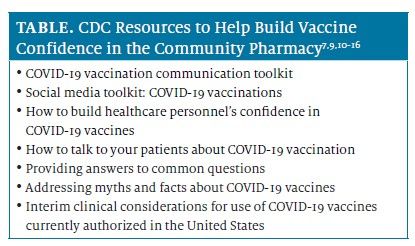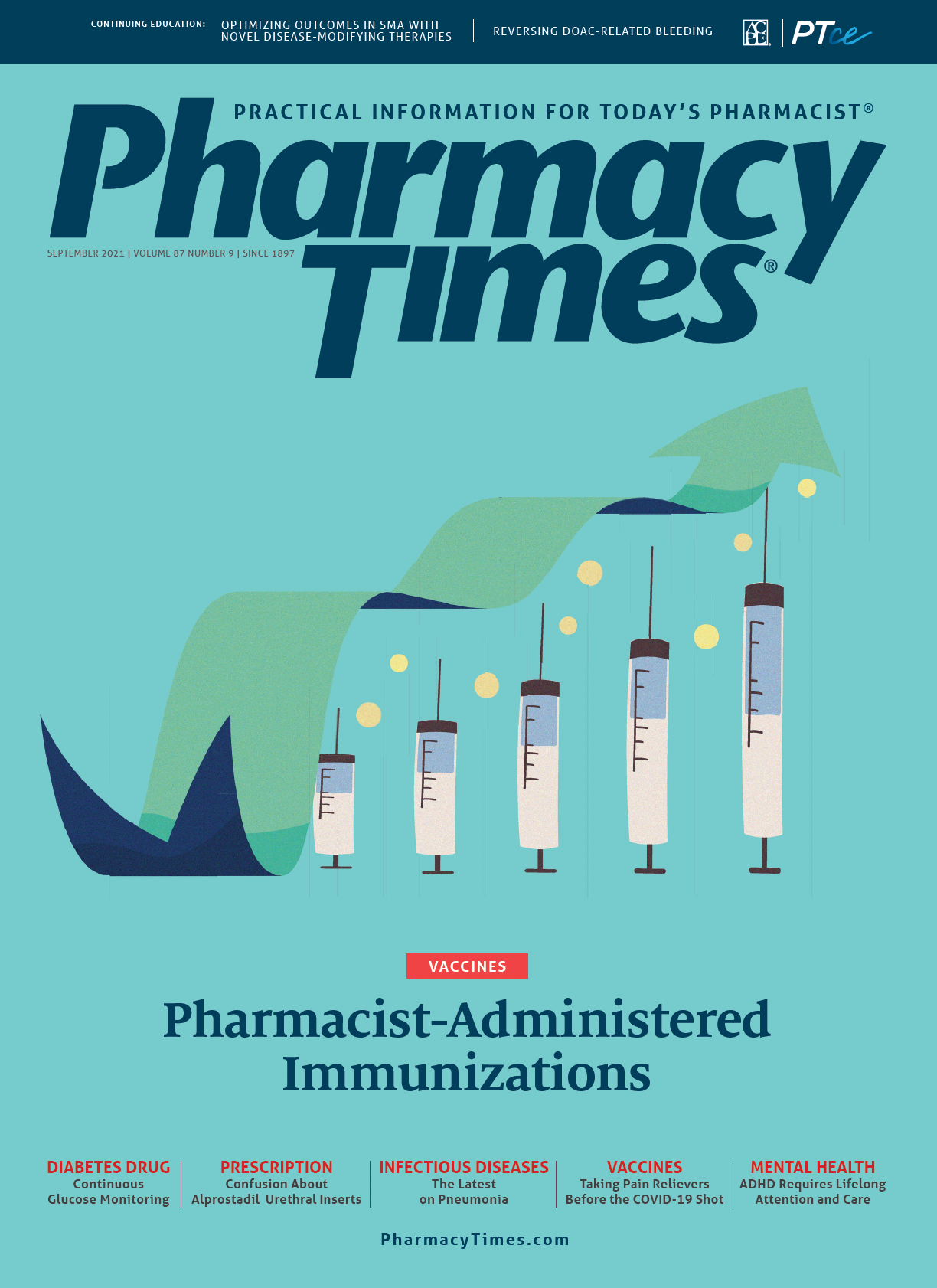Publication
Article
Pharmacy Times
Building COVID-19 Vaccine Confidence in the Community Pharmacy
This article was sponsored by Moderna.
In an effort to increase equitable access to COVID-19 vaccination across the United States, the White House launched the Federal Retail Pharmacy Program for COVID-19 Vaccination in February 2021.1,2 This program gives eligible individuals the ability to receive COVID-19 vaccinations at more than 40,000 participating pharmacy locations across the nation.1,3 Most Americans live within 5 miles of a pharmacy, which makes pharmacies readily accessible in diverse communities and positions them as critical players in the federal COVID-19 vaccination strategy.1,3
Americans seeking COVID-19 vaccination may enter the pharmacy with hesitation or questions regarding the available vaccines; therefore, pharmacists can prepare for conversations that can help their community understand the importance of vaccination and support their informed decision to be vaccinated.4-9
PHARMACISTS AS COVID-19 VACCINE ADVOCATES
Refer to the TABLE for a summary of resources available from the CDC website to support pharmacists in their roles as vaccine advocates.7,9,10-16

Providing education on COVID-19 vaccines
As of July 2021, 3 COVID-19 vaccines were authorized for use under an Emergency Use Authorization and recommended by the CDC Advisory Committee on Immunization Practices in the United States to prevent COVID-19: Pfizer-BioNTech, Moderna, and Janssen (Johnson & Johnson) COVID-19 vaccines.4-6,17-19
Pharmacists have an opportunity to educate the community regarding the risks and benefits of each vaccine, provide information relating to vaccine safety and efficacy, explain the benefits of high vaccination effectiveness, and answer questions about how the vaccines were developed.8 If asked whether vaccines were tested in all populations, pharmacists can explain that the clinical trials recruited a diverse mix of participants. It is important to be specific and provide the percentages of people included in the trials who had underlying health conditions, were from communities of color, and were older adults.9,13 Education should be offered in plain language and tailored to the individual’s level of health literacy.8
Strategies to build vaccine confidence
As defined by the CDC, vaccine confidence is “the trust that patients, parents, or providers have in recommended vaccines; providers who administer vaccines; and processes and policies that lead to vaccine development, licensure, manufacturing, and recommendations for use.”9,15 Pharmacists can strengthen confidence by starting conversations about vaccines, providing a strong recommendation, and addressing myths and hesitancy.8,9
Starting conversations about vaccines
Capturing public attention about vaccines is the first step in facilitating conversations with interested individuals. Signage about the availability of COVID-19 vaccines at the pharmacy placed on the building’s exterior can encourage individuals to inquire about more information from the pharmacist.16 Store employees should be encouraged to direct customers to the pharmacy section to discuss questions and concerns about COVID-19 vaccinations.15
Pharmacies can encourage vaccination through social media posts that include facts about how the vaccines were developed and answers to commonly asked questions (eg, side effects and immunity).10,16 This can be a useful way to disseminate COVID-19 vaccine information to individuals who do not frequent a pharmacy and to those who are hesitant about receiving a vaccine.
As another opportunity to engage in conversations about vaccines, pharmacists can identify patients with chronic medical conditions that are associated with high risk for severe COVID-19 (eg, heart conditions, cerebrovascular disease, lung conditions, diabetes mellitus) at prescription pickup and educate them on the importance of vaccination.20,21
Pharmacists can use approaches that will facilitate effective communication, such as listening to each individual’s perspective without making assumptions and responding in an empathetic and nonjudgmental manner. Starting with an open-ended question such as “What would you think about receiving a COVID-19 vaccination today?” can be effective in initiating a conversation. Messages should be clear, complete, and accurate to build trust in the vaccines and those who administer them.7,9
Hearing testimonials can be encouraging to those considering vaccination. Pharmacists can put individuals at ease by openly sharing their own personal experiences with vaccination, including that they received the vaccine, why they chose to get vaccinated, and why they encourage others to do the same.7 Pharmacists can emphasize how important it was to them to protect themselves and their families, coworkers, and communities. It is important that pharmacists convey a willingness to continue discussions and answer additional questions.7,15
Providing a strong recommendation
Pharmacists can make a strong, effective recommendation by saying, “I strongly recommend you get vaccinated. The vaccine will help protect you from getting COVID-19. If you still get infected after you get vaccinated, the vaccine may prevent serious illness. By getting vaccinated, you can also help protect people around you.” Recommendations can be tailored to the individual’s unique circumstance (eg, medical vulnerability, exposure risk at home or work).7,13
Addressing misinformation and vaccine hesitancy
By sharing credible and accurate information, pharmacists can proactively address and mitigate the spread and harm of misinformation regarding COVID-19 vaccination. Key facts to share include that COVID-19 vaccines cannot give people COVID-19, people who have already gotten sick with COVID-19 may still benefit from getting vaccinated, and getting vaccinated can help prevent getting sick with COVID-19. Pharmacists can also proactively explain side effects and provide information on the vaccines' safety and efficacy.7,9,11,13
VACCINE DEVELOPMENT
In response to the COVID-19 pandemic, viral vector-based and messenger RNA (mRNA)–based vaccines have been developed.4-6 Pharmacists can prepare to answer questions regarding the differences in vaccine types available. As an important message to convey, pharmacists should note that neither type of vaccine interacts with or integrates into a person’s DNA in any way.23,25
Viral vector-based vaccine
A viral vector-based vaccine uses a modified virus as a vector to deliver genetic material into human cells. Once inside human cells, the cell’s machinery uses the gene to produce/express a harmless piece of the virus, or antigen, and display it on cell surfaces. The presence of the antigen triggers an immune response in which antibodies are produced to help prepare the body to respond when it encounters the real infection in the future, for example,
COVID-19.23
Viral vector-based vaccines are also being studied as potential alternatives to common seasonal influenza vaccines. Due to the continuous antigenic drift of seasonal viruses, influenza vaccines need to be updated nearly each year to effectively target the specific strains in circulation. In addition, seasonal influenza vaccines do not protect against antigenically specific pandemic influenza viruses that typically have viral subtypes for which people do not have corresponding antibodies. Viral vector vaccines for influenza may address these challenges.24
Messenger RNA vaccine
mRNA-based vaccines have been studied for decades. They can be developed in a laboratory using readily available materials and produced relatively quickly in larger amounts than for traditional vaccines.25
mRNA is a single-stranded copy of DNA that travels from a cell’s nucleus to ribosomes in the cytoplasm, where it is translated into proteins. A vaccine based on mRNA technology does not use inactivated virus, attenuated virus, or any other kind of virus but instead includes a sequence of nucleoside-modified mRNA encoding viral antigens. This technology helps the body to produce the viral antigen itself, against which the body mounts an immune response.5,6,25 This allows the body to generate an antibody response, and to retain the information in memory immune cells with the goal of attacking the virus, for example the COVID-19 virus, if the vaccinated individual is exposed.
Advancements in mRNA technology can offer a different approach to personalized medicine and help innovate the development of future vaccines.
ROLE OF THE PHARMACIST
As COVID-19 vaccination providers, pharmacists are well positioned to address vaccine hesitancy, improve immunization rates, and build vaccine confidence in diverse communities. The resources provided in the TABLE can be used to help pharmacists initiate conversations about COVID-19 vaccination and prepare a strong, effective recommendation.7,9,10-16
REFERENCES
- Fact sheet: President Biden announces increased vaccine supply, initial launch of the federal retail pharmacy program, and expansion of FEMA reimbursement to states. Statements and releases. The White House. Published February 2, 2021. Accessed June 7, 2021.https://www.whitehouse.gov/briefing-room/statements-releases/2021/02/02/fact-sheet-president-biden-announces-increased-vaccine-supply-initial-launch-of-the-federal-retail-pharmacy-program-and-expansion-of-fema-reimbursement-to-states/
- Pharmacies participating in the federal retail pharmacy program. CDC. Page reviewed April 23, 2021. https://www.cdc.gov/vaccines/covid-19/retail-pharmacy-program/participating-pharmacies.html
- Understanding the federal retail pharmacy program for COVID-19 vaccination. CDC. Page reviewed June 15, 2021. Accessed June 25, 2021. https://www.cdc.gov/vaccines/covid-19/retail-pharmacy-program/index.html
- Janssen COVID-19 Vaccine. Prescribing Information. Janssen Biotech. Revised April 23, 2021. Accessed June 7, 2021. https://www.janssenlabels.com/emergency-use-authorization/Janssen+COVID-19+Vaccine-HCP-fact-sheet.pdf
- Moderna COVID-19 Vaccine. Prescribing Information. Moderna,. Revised March 31, 2021. Accessed June 7, 2021. https://www.modernatx.com/covid19vaccine-eua/eua-fact-sheet-providers.pdf
- Pfizer-BioNTech COVID-19 Vaccine. Prescribing Information. Pfizer-BioNTech Manufacturing GmbH. Revised June 25, 2021. Accessed June 7, 2021. http://labeling.pfizer.com/ShowLabeling.aspx?id=14471&format=pdf&#page=13
- How to talk to your patients about COVID-19 vaccination. CDC. Last reviewed: June 2, 2021. Accessed June 7, 2021. https://www.cdc.gov/vaccines/covid-19/hcp/engaging-patients.html
- Chou WY, Burgdorf CE, Gaysynsky A, Hunter CM. COVID-19 vaccination* communication: applying behavioral and social science to address vaccine hesitancy and foster vaccine confidence. National Institutes of Health. December 2020. Accessed June 24, 2021. https://obssr.od.nih.gov/wp-content/uploads/2020/12/COVIDReport_Final.pdf
- CDC COVID-19 Response Vaccine Task Force. Building confidence in COVID-19 vaccines among your patients tips for the healthcare team. CDC. Published January 2021. Accessed June 7, 2021. https://www.cdc.gov/vaccines/covid-19/downloads/VaccinateWConfidence-TipsForHCTeams_508.pdf
- Social media tookit: COVID-19 vaccinations. CDC. Updated June 4, 2021. Accessed June 24, 2021. https://www.cdc.gov/coronavirus/2019-ncov/communication/vaccination-toolkit.html
- Myths and facts about COVID-19 vaccines. CDC. Updated June 23, 2021. Accessed June 25, 2021. https://www.cdc.gov/coronavirus/2019-ncov/vaccines/facts.html
- Answering your questions about the safety and effectiveness of COVID-19 vaccine. CDC. Accessed June 7, 2021. https://www.cdc.gov/vaccines/covid-19/downloads/hcp-employees-general-faqs-508.pdf
- Quick answers for healthcare professionals to common questions people may ask about COVID-19 vaccines. CDC. Accessed June 7, 2021. https://www.cdc.gov/vaccines/covid-19/downloads/healthcare-professionals-vaccine-quick-answers.pdf
- Interim clinical considerations for use of COVID-19 vaccines currently authorized in the United States. CDC. Updated June 1, 2021. Accessed June 7, 2021.https://www.cdc.gov/vaccines/covid-19/clinical-considerations/covid-19-vaccines-us.html
- How to build healthcare personnel’s confidence in COVID-19 vaccines. CDC. January 29, 2021. Accessed June 7, 2021. https://www.cdc.gov/vaccines/covid-19/downloads/Build-Healthcare-Personnel-Confidence.pdf
- Communication resources for COVID-19 vaccines. CDC. Updated June 10, 2021. Accessed June 27, 2021. https://www.cdc.gov/coronavirus/2019-ncov/vaccines/resource-center.html
- How CDC is making COVID-19 vaccine recommendations. CDC. Updated May 14, 2021. Accessed June 25, 2021. https://www.cdc.gov/coronavirus/2019-ncov/vaccines/recommendations-process.html
- Wallace M, Woodworth KR, Gargano JW, et al. The Advisory Committee on Immunization Practices’ interim recommendation for use of Pfizer-BioNTech COVID-19 vaccine in adolescents aged 12–15 years — United States, May 2021. MMWR Morb Mortal Wkly Rep. 2021;70:749–752. https://www.cdc.gov/mmwr/volumes/70/wr/mm7020e1.htm
- COVID-19 ACIP vaccine recommendations. CDC. Page last reviewed: May 17, 2021. Accessed June 25, 2021. https://www.cdc.gov/vaccines/hcp/acip-recs/vacc-specific/covid-19.html
- Underlying medical conditions associated with high risk for severe COVID-19: information for healthcare providers. CDC. Updated May 13, 2021. Accessed June 25, 2021. https://www.cdc.gov/coronavirus/2019-ncov/hcp/clinical-care/underlyingconditions.html
- People with certain medical conditions. CDC. Updated May 13, 2021. Accessed June 27, 2021. https://www.cdc.gov/coronavirus/2019-ncov/need-extra-precautions/people-with-medical-conditions.html
- Vaccine types. HHS. Reviewed April 29, 2021. Accessed June 24, 2021. https://www.hhs.gov/immunization/basics/types/index.html
- Understanding viral vector COVID-19 vaccines. CDC. Updated April 13, 2021. Accessed June 24, 2021. https://www.cdc.gov/coronavirus/2019-ncov/vaccines/different-vaccines/viralvector.html
- de Vries RD, Rimmelzwaan GF. Viral vector-based influenza vaccines. Hum Vaccin Immunother. 2016;12(11):2881-2901. doi:10.1080/21645515.2016.1210729
- Understanding mRNA COVID-19 vaccines. CDC. Updated March 4, 2021. Accessed June 25, 2021. https://www.cdc.gov/coronavirus/2019-ncov/vaccines/different-vaccines/mrna.html
- mRNA personalized cancer vaccines and immuno-oncology. Moderna. 2021. Accessed June 28, 2021. https://www.modernatx.com/pipeline/therapeutic-areas/mrna-personalized-cancer-vaccines-and-immuno-oncology








